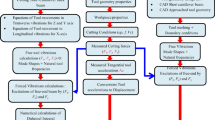Abstract
In this work, we present a modeling of the dynamic behavior of a turning tool. The goal is to show that it is possible to estimate the roughness average of the workpiece starting from resulting displacement from the tool nozzle. The tool is modeled by the Euler beam clamped-free, excited by the cutting force at its free end. The formulation of the motion equations of the tool is based on the Hamilton variational principle and their resolutions are carried out by the modal method and the Duhamel integral. As the excitation is unspecified, the integrals are evaluated numerically. The three components of the cutting force, obtained experimentally, permit to calculate the tool nozzle displacements. The comparison of the calculated average roughness with the measured one shows a good agreement. We present also a validation of the experimental results of the resulting displacement of the tool nozzle with the calculated displacement.




























Similar content being viewed by others
References
Bourdim A, Rahmani O, Boutchicha D (1993) Simulation numérique du phénomène de broutage. Premier congrès de mécanique ENIM, Rabat, pp 22–27 Avril
Arfaoui A, Fedotov AI, Chouchane M, Modélisation des vibrations de l’outil de coupe en tournage, Premier congrès de mécanique, ENIM, Rabat, pp 331-342, Av.93.
Anderson JL, Chiffre L (1993) Automatic chip-breaking detection in turning by frequency analysis of cutting force. CIRP Ann 42(1):45–48
Kato S, Marui E, (1974) On the cause of regenerative chatter due to workpiece deflection, ASME, J Eng Ind, pp 179-186
Younes R, Chalfoun J, Alayli Y, Wagstaff P. (2004) Stability study for cutting vibrations. XIV Colloque vibration choc and vibrations 16-18 June
Zapciu M, Cahuc O, Bisu CF, Gérard A, K’Nevez J-Y (2009) Experimental study of machining system: dynamic characterization. J Mach Form Technol 1(3-4):1–18
Insperger T, Barton DAW, Stepan G (2008) Criticality of Hopf bifurcation in state dependent delay model turning processes. Int J Non-Linear Mech 43:140–149
Chen CK, Tsao YM (2006) A stability analysis of regenerative chatter in turning process without using tailstock. Int J Adv Manuf Technol 29:648–654
Qi K, He Z, Li Z, Zi Y, Chen X (2008) Vibration based operational modal analysis of rotor systems. Measurement 41:810–816
Dassanayake AV, Suh CS (2008) On nonlinear cutting response and tool chatter in turning operation. Commun Nonlinear Sci Numer Simul 13:979–1001
El-Sinawi AH, Kashani R (2005) Improving surface roughness in turning using optimal control of tool’s radial position. J Mater Process Technol 167:54–61
Moufki A, Devillez A, Segreti M, Dudzinski D (2006) A semi-analytical model of non-linear vibrations in orthogonal cutting and experimental validation. Int J Mach Tool Manu 46:436–449
Kribes N memoire de magister 2003 Etude semi experimentale du comportement vibratoire de l’outil de coupe lors de l’opération de chariotage.
Kribes N thèse de doctorat 2009 Influences des vibrations sur la rugosité d’étatde surfaces des pièces usinées en tournage
Zahia H, Nabil K, Yalles MA, Mabrouki T, Ouelaa N, Rigal J-F (2013) Turning roughness model based on tool-nose displacements ISSN 1392 - 1207. Mechanika. 19(1):112–119
Acknowledgments
The authors wish to thank the technical assistance during the machining in the LMS Laboratory (Université 8 Mai 1945, Guelma, Algeria), where this research work was carried out. The Algerian General Direction of Research (DGRSDT) is also acknowledged for its support.
Author information
Authors and Affiliations
Corresponding author
Additional information
Publisher’s note
Springer Nature remains neutral with regard to jurisdictional claims in published maps and institutional affiliations.
Rights and permissions
About this article
Cite this article
Kribes, N., Rezaiguia, A., Ouelaa, N. et al. Estimation of average roughness of X200Cr12 steel using displacement from the tool nozzle. Int J Adv Manuf Technol 110, 3323–3337 (2020). https://doi.org/10.1007/s00170-020-06067-2
Received:
Accepted:
Published:
Issue Date:
DOI: https://doi.org/10.1007/s00170-020-06067-2



